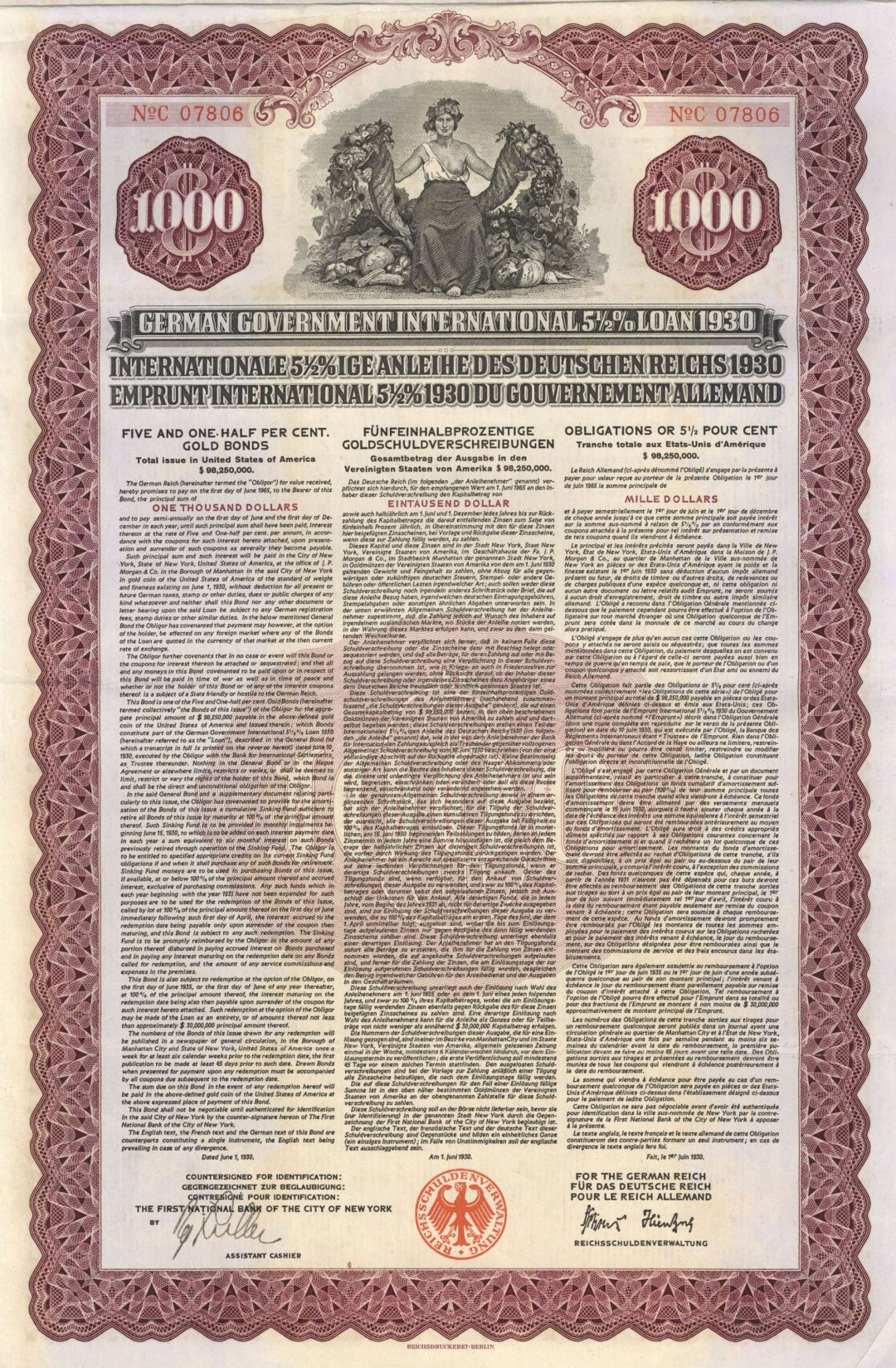German Young Gold Loan 1930 Uncancelled $1,000 Denominated Bond with Pass-co Authentication (Uncanceled)
Inv# FB6008 Bond
German Government International 5 1/2% Loan 1930 Uncanceled Bond. Traditional remaining amount of 41 coupons attached. Text in English, German, and French. INCLUDES A PASS-CO AUTHENTICATION
The Young Plan was an initiative aimed at resolving Germany's reparations from World War I, drafted in August 1929 and officially accepted in 1930. It was introduced by a committee led by American industrialist Owen D. Young, who was the founder and former chairman of the Radio Corporation of America (RCA). At that time, he also served on the board of trustees for the Rockefeller Foundation and had previously participated in the Dawes Plan of 1924, which was another arrangement for restructuring war reparations. The Inter-Allied Reparations Commission determined the German reparation amount to be a theoretical total of 132 billion, but the practical total was set at 50 billion gold marks. Once the Dawes Plan was implemented in 1924, it became clear that Germany would be unwilling to fulfill the annual payments indefinitely. The Young Plan subsequently reduced these payments by approximately 20 percent. Although the theoretical total was 112 billion Gold Marks, which was equivalent to around $27 billion in 1929 (or $121 billion in 2021), spread over 58 years concluding in 1988, few anticipated that the plan would endure for more than a decade.
Furthermore, the Young Plan structured the annual payment, fixed at two billion Gold Marks (approximately $473 million), into two parts: one unconditional portion, amounting to one third of the total, and a postponable portion, comprising the remaining two-thirds, which would accrue interest and be financed by a consortium of American investment banks led by J.P. Morgan & Co. The committee, appointed by the Allied Reparations Committee, convened in the first half of 1929 and presented its initial report on June 7 of that year. Alongside Young, the United States was represented by prominent banker J. P. Morgan, Jr. and his associate, Thomas W. Lamont. The report faced significant opposition from the United Kingdom; however, following an initial conference in The Hague, a plan was finalized on August 31. The plan was officially adopted during a second Hague Conference in January 1930.
Among other provisions, the plan proposed the establishment of an international bank of settlements to manage the reparations transfers. Consequently, the Bank for International Settlements was officially founded at the Hague Conference in January. Between the agreement and the adoption of the plan, the Wall Street Crash of October 1929 occurred, leading to two primary consequences. The American banking system was compelled to withdraw funds from Europe and cancel the credits that facilitated the Young Plan. Additionally, the decline in imports and exports had repercussions for the global economy. By 1933, nearly two-thirds of world trade had disappeared. A new trade policy was introduced with the Smoot–Hawley Tariff Act, which was shaped by nationalism and the prevailing economic policy. Unemployment rates surged to 33.7% in Germany in 1931 and reached 40% in 1932. In light of these circumstances, U.S. President Herbert Hoover issued a public statement advocating for a one-year moratorium on the payments. By July 1931, he successfully garnered support for the moratorium from 15 nations. However, the implementation of the moratorium did little to mitigate the economic downturn in Europe. Germany found itself in the throes of a significant banking crisis. A final attempt to address the situation was made at the Lausanne Conference in 1932, where representatives from Great Britain, France, Italy, Belgium, Germany, and Japan convened to reach an agreement. By that point, it had become evident that the worsening depression rendered it impossible for Germany to resume its reparations payments. They reached an agreement:
- Do not urge Germany for prompt payments.
- To decrease the debt by almost 90% and necessitate Germany's preparation for bond issuance. This clause was nearly revoked, lowering the German liability from the initial $32.3 billion to $713 million.
- It was informally concurred among the delegates that these stipulations would not be effective unless the US government consented to the annulment of war debts owed by the Allied nations.
Hoover issued the necessary public statement regarding the absence of any link between reparations and war debts; however, in December 1932, the U.S. Congress dismissed the Allied war debt reduction proposal. This effectively meant that the war reparations and debts reverted to the debt reduction previously granted to Germany under the 1929 Young Plan. Nevertheless, the system had collapsed, and Germany ceased payments. Once the National Socialist government secured its power, the debt was repudiated, and Germany made no additional payments. By 1933, Germany had only fulfilled one-eighth of the reparations required under the Treaty of Versailles for World War I, and due to the repudiated American loans, the United States effectively paid "reparations" to Germany. The plan ultimately failed, not due to the U.S. Congress' refusal to cooperate, but because it became irrelevant following Hitler's ascension to power.
Following Germany's defeat in World War II, an international conference (the London Agreement on German External Debts, 1953) determined that Germany would settle the remaining debt only after the country was reunified. Nevertheless, West Germany settled the principal by 1980; then in 1995, after reunification, the new German government declared it would resume interest payments. Germany was scheduled to complete interest payments to the United States in 2010 and to other nations in 2020. In 2010, Time reported that Germany made its "final reparations-related payment for the Great War on Oct. 3, nearly 92 years after the country's defeat by the Allies." This agreement was preceded by intense diplomatic conflicts, and its acceptance stirred nationalist sentiments and resentment. It also undermined, rather than supported, the proponents of a policy aimed at fostering international understanding.
Despite the fact that the Young Plan had significantly diminished Germany's obligations, it faced opposition from various segments of the political landscape in Germany. The conservative factions were particularly vocal in their dissent against reparations and capitalized on the resistance to the Young Plan as a political issue. A coalition emerged, comprising several conservative groups, led by Alfred Hugenberg, who was the head of the German National People's Party. Among the groups that joined this coalition was Adolf Hitler and the National Socialist German Workers Party. The coalition aimed to enact the Freiheitsgesetz ("Liberty Law").
This legislation would reject all reparations and criminalize any cooperation by German officials in their collection. Additionally, it would disavow Germany's acceptance of "war guilt" and the occupation of German territory, both of which were stipulations of the Treaty of Versailles. According to the German constitution, if ten percent of eligible voters in the nation signed a petition supporting a proposed law, the Reichstag was obligated to bring the issue to a vote. Should the Reichstag reject the law, the proposal would automatically be subjected to a national referendum. If fifty percent of the populace voted in favor, it would be enacted as law.
The proposal for the Liberty Law was officially introduced on October 16, 1929. The National Socialists and other factions organized large public rallies to gather signatures. The government opposed the Liberty Law and organized counter-demonstrations. Nevertheless, the coalition managed to collect sufficient signatures to present the proposal to the Reichstag. The Reichstag ultimately rejected the bill with a vote of 318 to 82. In the subsequent popular vote on December 22, during the Liberty Law referendum, voter turnout was merely 14.9%, although an overwhelming 94.5% of the votes cast (equating to 13.8% of registered voters) supported the proposed legislation.
Although the Liberty Law was not passed in 1929, the campaign advocating for it significantly contributed to the integration of Hitler and the National Socialists into the political mainstream. After their defeat, Hitler criticized Hugenberg, attributing the loss to his inadequate leadership. Consequently, Hugenberg and numerous other conservatives soon found themselves overshadowed by the National Socialists. Following his rise to power, Hitler would later implement most of the Liberty Law's proposals through decree. Events in Germany during 1930:
- 23 January - The Nazi Party secures its first minister as Wilhelm Frick is appointed Minister of the Interior and Education in Thuringia, as part of a right-wing coalition government.
- 27 March - The administration of Hermann Müller collapses.
- 30 March - A right-of-center minority government is established under Heinrich Brüning.
- 22 June - The Nazi Party's growth continues, making them the second largest party in the Landtag of Saxony.
- 30 June - The French Army withdraws its forces from the Rhineland.
- 16 July - The government invokes a Presidential Decree to push through its economic reforms.
- 18 July - The Social Democratic Party of Germany (SPD) successfully votes against the rule by decree, leading to the dissolution of the Reichstag and new elections. July - The German State Party is formed through the merger of the German Democratic Party and the Young German Order.
- 13 August - The Roman Catholic Archdiocese of Berlin is established.
- 14 September - In the federal election, the SPD retains its position as the largest party, while the Nazis rise to second place. Smaller gains are made by the Communist Party of Germany, the Christian-National Peasants' and Farmers' Party, and the Centre Party, whereas the main losers are the German National People's Party and the German People's Party.
A bond is a document of title for a loan. Bonds are issued, not only by businesses, but also by national, state or city governments, or other public bodies, or sometimes by individuals. Bonds are a loan to the company or other body. They are normally repayable within a stated period of time. Bonds earn interest at a fixed rate, which must usually be paid by the undertaking regardless of its financial results. A bondholder is a creditor of the undertaking.











Ebay ID: labarre_galleries